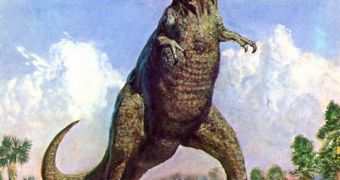New evidence uncovered by scientists working with the University of Kansas proves that T. rex was not a scavenger, but an active hunter that did not hesitate to chase after live prey when the opportunity presented itself.
Until recently, it was believed that, despite its scary looks, this ancient predator fed on carcasses it chanced to come across.
Thus, paleontologists have discovered many T. rex teeth stuck in the fossilized remains of dinosaurs this predator shared its natural habitat with.
However, they have been unable to say whether the T. rex the teeth belonged to bit into the other dinosaur while the other was alive or dead.
Writing in the journal Proceedings of the National of Sciences, the University of Kansas researchers claim that they have discovered a T. rex tooth embedded in the bones of a herbivorous duck-billed hadrosaur's tail.
What makes their find stand out amongst many others of its kind is the fact that the herbivorous dinosaur's tail bones appear to have continued growing even after the T. rex's tooth got lodged in them.
This indicates that the T. rex attacked the duck-billed hadrosaur, bit its tail, lost one of its teeth and then also lost its next meal, Nature explains.
The herbivorous dinosaur must have continued living for a considerable period of time. While its body was recovering from the attack, new bone tissue engulfed part of the T. rex's tooth.
“Here we report definitive evidence of predation by T. rex: a tooth crown embedded in a hadrosaurid caudal centrum, surrounded by healed bone growth,” the scientists write in their paper.
“This indicates that the prey escaped and lived for some time after the injury, providing direct evidence of predatory behavior by T. rex,” they further detail.
The duck-billed hadrosaur specimen whose tail still had the predator's tooth stuck in it was dug out in South Dakota from a fossil locality dubbed Hell Creek Formation.

 14 DAY TRIAL //
14 DAY TRIAL //